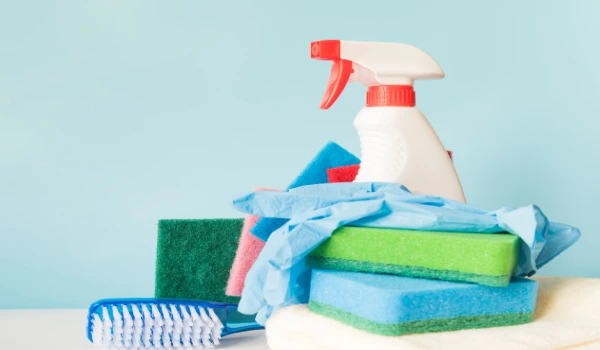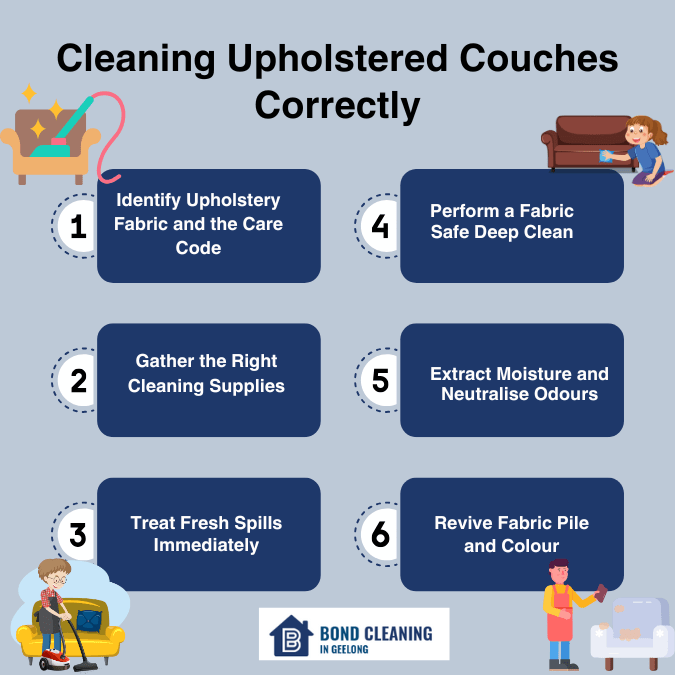
How To Clean Upholstery Couch The Right Way
It’s movie night, you’re curled up on your couch with snacks and drinks and then – oops – a spill. Whether it’s a splash of wine, a smudge of chocolate or just everyday wear, your cosy couch often takes the hit. Whether it’s spring cleaning season or just time to freshen up your living space, your couch deserves some attention.
Over time, upholstery traps dust, pet hair, stains and odours that regular vacuuming can’t remove. But with the right tools and a bit of knowhow, you can restore your couch’s comfort and appearance without causing damage. This guide breaks down the correct method to clean your upholstered couch safely and effectively. Whether you’re preparing for guests or are in need of a deep clean as part of the professional end of lease cleaning Geelong requirements, these steps will help you get things done properly. By the end, you’ll have a fresh, inviting couch that looks as good as it feels.
Hide
Show
- Identify Upholstery Fabric and the Care Code
- Gather the Right Cleaning Supplies
- Treat Fresh Spills Immediately
- Perform a Fabric Safe Deep Clean
- Extract Moisture and Neutralise Odours
- Revive Fabric Pile and Colour
- Prevent Future Stains with Everyday Habits
- Know When to Call a Professional
- Wrapping Up
1. Identify Upholstery Fabric and the Care Code
Before you grab hold of the nearest spray bottle, take a moment to locate the manufacturer’s care tag, usually hidden under a cushion or along the frame. The code will read W, S, WS or X. If you see a “W”, it means that the fabric can tolerate water based cleaners, while “S” calls for solvent based cleaners. “WS” allows either option and “X” indicates vacuum only. Ignoring these letters risks water rings, colour bleeding or fabric shrinkage. If the tag is missing, test any cleaner on an inconspicuous area first. A simple dab behind the skirt with a white cloth can save you from a blotchy disaster on the seat cushions.
2. Gather the Right Cleaning Supplies

A successful clean relies more on preparation than on elbow grease. Lay out a soft bristle brush, a clean microfiber cloth, a white terry towel, a bucket of warm water, gentle dishwashing liquid, rubbing alcohol or specialty upholstery solvent (for “S” fabrics), and a handheld vacuum with an upholstery attachment. Having everything within easy reach prevents you from leaving wet solution sitting on the fabric for too long while you dart off to the laundry room for supplies. If you expect heavy soil or old stains, consider renting a hot water extractor machine designed to clean upholstery; they’re inexpensive and are far less aggressive than a full size carpet unit.
3. Treat Fresh Spills Immediately
Speed is your best friend when an accident happens. Blot, don’t ever rub. Do this with a white cloth to lift away as much of the liquid as possible. Press firmly and keep turning the cloth to a clean spot so you’re absorbing, not smearing the stain. For sticky residues like chocolate, gently scrape off excess with a dull knife before blotting. Mix a few drops of mild dishwashing liquid into warm water, dip the cloth, wring it out well and dab outwards from the centre of the stain towards the edges. This technique prevents a visible “clean halo” from appearing.
Rinse the cloth in plain water, wring out again and dab to remove soap residue. Proper blotting now makes later deep cleaning much easier. This step is vital when you’re tackling chores related to thorough End of lease cleaning Geelong, which demand spotless upholstery.
4. Perform a Fabric Safe Deep Clean
Once all the surface mess is gone, move on to giving the couch a thorough clean. For W or WS fabrics, create a solution of one teaspoon of mild detergent per litre of warm water. Lightly mist a section with a spray bottle, and then use a soft bristled brush to agitate in small circular motions. Work on one cushion or a 30cm patch at a time to avoid overwetting.
After brushing, blot with the terry towel to lift away dirt and excess moisture. Repeat it until the towel comes away relatively clean. For “S” only materials pour a small amount of rubbing alcohol or specialty solvent onto a microfiber cloth and dab; alcohol evaporates quickly, reducing the risk of watermarking. Keep windows open so fumes disperse and fabric dries faster.
5. Extract Moisture and Neutralise Odours
Even minimal liquid can become musty if it lingers. Point a fan at the couch or, on a fine day, open the sliding door to encourage cross breeze. Swap damp towels for dry ones and press firmly to wick out deeper moisture. Once the surface feels dry to the touch, liberally sprinkle bicarb soda over the cushions and in the crevices. Let it sit for an hour (overnight is ideal) to absorb residual smells. Vacuum thoroughly with the upholstery nozzle, especially in the seams where baking soda can settle.
This simple step leaves the couch smelling neutral instead of perfumed, something which is important when handing back the keys to your landlord for a strict End of Lease Cleaning Geelong inspection. In this scenario, the presence of artificial fragrances can raise questions about hidden odours.
6. Revive Fabric Pile and Colour
To bring back that showroom nap, run a clean, slightly damp white cloth over the surface in the direction of the weave, and then brush gently with a dry, soft bristled brush. Light misting with distilled water can relax flattened fibres; don’t soak them. For faded spots, fabric safe upholstery dye pens can recolour small areas, but before you use it, test it out first.
Sunlight can accelerate fading, so rotate cushions monthly and pull lounge sets slightly away from large windows. A regular grooming routine not only keeps the couch looking plush but also extends fabric lifespan by reducing abrasive dust build up.
7. Prevent Future Stains with Everyday Habits
Slipcovers aren’t the only defence. Encourage your family to enjoy snacks at the dining table, keep pet throws on their favourite perches and adopt a weekly vacuum schedule that targets crumbs before they grind into the fibers. Place washable armrest caps on high wear edges and consider having a professional apply a fluoropolymer fabric protectant on it. This forms an invisible barrier so spills bead on the surface rather than seeping in, buying you time to blot. These habits will make your next deep clean a quick refresh rather than a full day project.
8. Know When to Call a Professional
Some stains, (old red wine, ink, oil) bond chemically with fibres and require industrial gear. A certified upholstery technician can clean your couch using hot water or special dry cleaning methods for delicate fabrics. Many companies offer package deals that include couch, carpet, mattress, or curtain cleaning, saving you a call out fee. If your couch was expensive, a yearly professional clean will protect it and may even keep the warranty valid. When moving out, landlords often ask for proof of professional cleaning, so book them beforehand to get your bond back and avoid last minute stress.
Cleaning Upholstered Couches Correctly

Wrapping Up
With a clear care tag, the right products and consistent habits, keeping your upholstery couch spotless is simpler than it seems. Follow these steps regularly and your couch will remain a comfy, welcoming centrepiece of your living room for years. Happy Cleaning!

